ICP N2H330AKA100, C2H330GKA100 Owner’s Manual
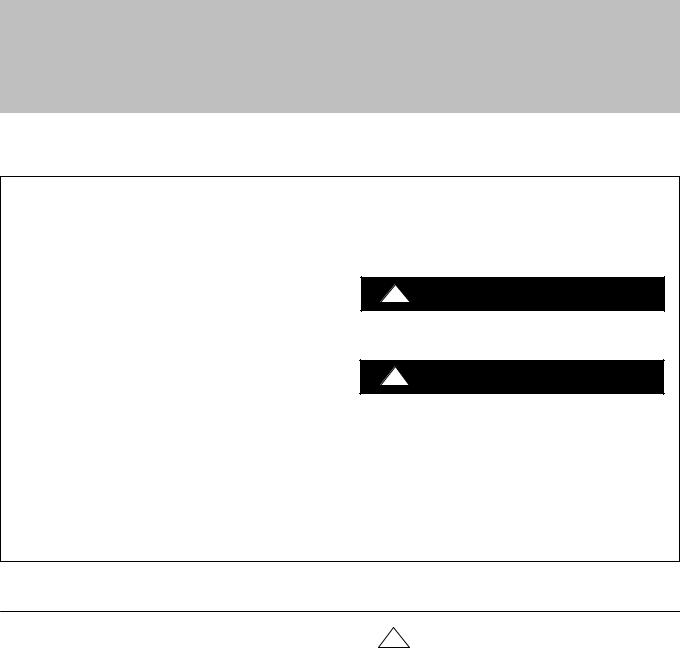
INSTALLATION INSTRUCTIONS
R−22 Split System Heat Pump
Product Family: N2H3, H2H3, C2H3, T2H3, N2H4
These instructions must be read and understood completely before attempting installation.
Safety Labeling and Signal Words
DANGER, WARNING, CAUTION, and
NOTE
The signal words DANGER, WARNING, CAUTION, and NOTE are used to identify levels of hazard seriousness. The signal word DANGER is only used on product labels to signify an immediate hazard. The signal words WARNING, CAUTION, and NOTE will be used on product labels and throughout this manual and other manuals that may apply to the product.
DANGER − Immediate hazards which will result in severe personal injury or death.
WARNING − Hazards or unsafe practices which could result in severe personal injury or death.
CAUTION − Hazards or unsafe practices which may result in minor personal injury or product or property damage.
NOTE − Used to highlight suggestions which will result in enhanced installation, reliability, or operation.
Signal Words in Manuals
The signal word WARNING is used throughout this manual in the following manner:
!WARNINGWAR ING
The signal word CAUTION is used throughout this manual in the following manner:
!CAUTION
Signal Words on Product Labeling
Signal words are used in combination with colors and/or pictures on product labels.
TABLE OF CONTENTS
Inspect New Unit |
2 |
! |
WARNING |
|
Safety Considerations |
2 |
|||
|
|
|||
. . . . . . . . . . . . . . . . . . . . . . . . . . . . . . . . . . .Location |
. . . . 2 |
DEATH, PERSONAL INJURY, AND/OR PROPERTY |
||
|
|
|||
Clearances . . . . . . . . . . . . . . . . . . . . . . . . . . . . . . . . |
. 2 − 3 |
DAMAGE HAZARD |
||
Unit Support . . . . . . . . . . . . . . . . . . . . . . . . . . . . . . . |
. . . . 4 |
Failure to carefully read and follow this warning |
||
Refrigeration System |
5 − 9 |
could result in equipment malfunction, property |
||
damage, personal injury and/or death. |
||||
Electrical Wiring |
9 − 10 |
|||
Installation |
or repairs made by unqualified per- |
|||
Defrost System |
11 |
|||
sons could result in equipment malfunction, prop- |
||||
|
|
|||
Start−up Procedure . . . . . . . . . . . . . . . . . . . . . . . . . |
. . . 12 |
erty damage, personal injury and/or death. |
||
Refrigerant Charge . . . . . . . . . . . . . . . . . . . . . . . . |
12 − 13 |
The information contained in this manual is in- |
||
Sequence of Operation |
14 |
tended for use by a qualified service technician fa- |
||
miliar with safety procedures and equipped with |
||||
Troubleshooting |
14 |
|||
the proper |
tools and test instruments. |
|||
Maintenance . . . . . . . . . . . . . . . . . . . . . . . . . . . . . . . |
. . . 14 |
Installation must conform with local building |
||
|
|
|||
Comfort Alertt Diagnostics Codes . . . . . . . . . . . |
. . . 15 |
codes and with the National Electrical Code |
||
|
|
NFPA70 current edition or Canadian Electrical |
||
|
|
Code Part 1 CSA C.22.1. |
||
|
|
|
|
|
428 01 5002 00 Aug 2008
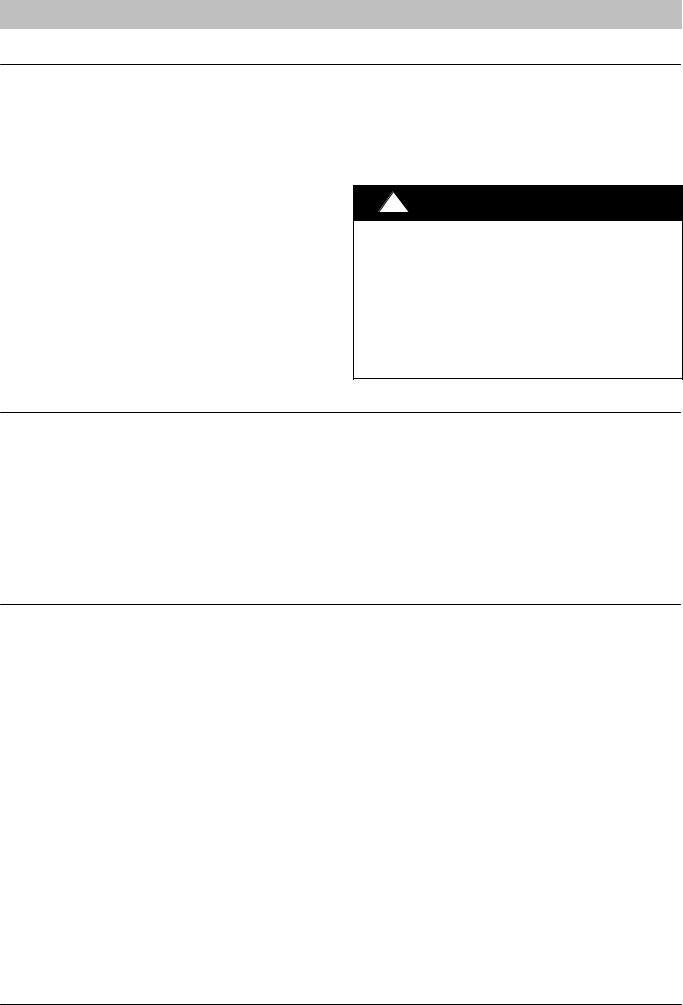
INSTALLATION INSTRUCTIONS R−22 Split System Heat Pump
INSPECT NEW UNIT
After uncrating unit, inspect thoroughly for hidden |
company immediately and file a concealed damage |
|
damage. If damage is found, notify the transportation |
claim. |
|
SAFETY CONSIDERATIONS |
|
|
Consult a qualified installer, service agency, or the dealer/distributor for information and assistance. The qualified installer must use factory authorized kits and accessories when modifying this product. Refer to the individual instructions packaged with the kit or accessory when installing.
The weight of the product requires careful and proper handling procedures when lifting or moving to avoid personal injury. Use care to avoid contact with sharp or pointed edges.
Follow all safety codes. Wear safety glasses, protective clothing, and work gloves. Use a heat sinking material − such as a wet rag − during brazing operations. Keep a fire extinguisher available. Consult local codes and the National Electric Code (NEC) for special requirements.
Improper installation, adjustment, alteration, service or maintenance can void the warranty.
!WARNING
ELECTRICAL SHOCK HAZARD
Failure to turn off the main (remote) electrical disconnect device could result in personal injury or death.
Before installing, modifying or servicing system, turn OFF the main (remote) electrical disconnect device. There may be more than one disconnect device. Lock out and tag switch with a suitable warning label.
LOCATION
Check local codes for regulations concerning zoning, noise, platforms, and other issues.
Locate unit away from fresh air intakes, vents, or bedroom windows. Noise may carry into the openings and disturb people inside.
Locate unit in a well drained area, or support unit high enough so that water runoff will not enter the unit.
Locate unit away from areas where heat, lint, or exhaust fumes will be discharged onto unit (as from dryer vents).
Locate unit away from recessed or confined areas where recirculation of discharge air may occur (refer to CLEARANCES section of this document).
Roof−top installation is acceptable providing the roof will support the unit and provisions are made for water drainage and noise/vibration dampening.
NOTE: Roof mounted units exposed to wind may require wind baffles. Consult the manufacturer for additional information.
CLEARANCES
Nominal minimum clearances are 48 inches (1.2m) above unit for discharge air and 18 inches (457mm) on each side of the coil for intake air. Clearance on any one side of the coil (normally between unit and structure) may be reduced to 6 inches (152mm). Nominal minimum clearances are based on a solid parallel object such as a wall or roof overhang.
The clearance may be reduced for a single object with small surface area, such as the end of a wall, outside corner of a wall, fence section, post, etc. As a general rule, the minimum clearance from the unit should equal the width of the object. For example, a 6 inch (152mm) fence post should be a minimum of 6 inches (152mm) from the unit.
Do not install unit under roof overhangs unless gutters are present. A minimum vertical clearance of 48 inches (1.2m) is required to the overhang.
Inside corner locations on single story structures require evaluation. Large overhanging soffits may cause air recirculation in a corner area even though recommended minimum clearances are maintained. As a guide, locate the unit far enough out so that half of the discharge grille is out from under the soffit.
When placing two or more units side−by−side, provide a minimum of 18 inches (457mm) between units.
Provide minimum service clearance of 24 inches (610mm) from control box corner and side service panel.
Refer to Figure 1.
2 |
428 01 5002 00 |
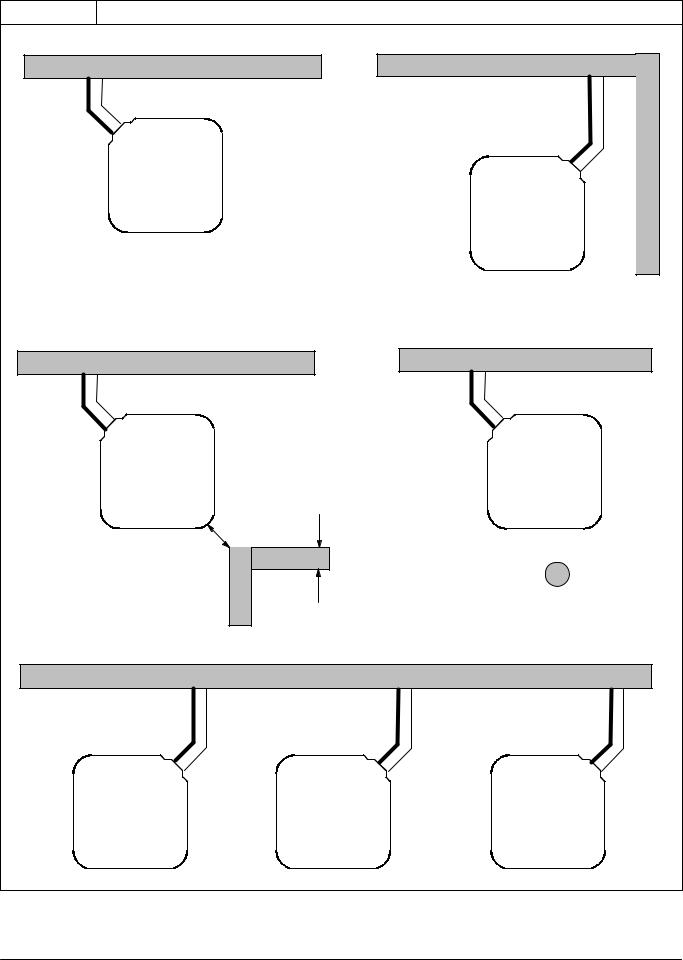
INSTALLATION INSTRUCTIONS |
R−22 Split System Heat Pump |
|
|
Figure 1 |
|
Clearances (various examples) |
|
|
Wall |
|
|
Wall |
|
6” |
|
|
|
|
(152mm) |
|
|
24” |
|
|
|
|
(610mm) |
|
|
|
|
Service |
|
24” |
18” |
|
|
|
(610mm) |
(457mm) |
|
6” |
|
Service |
|
|
||
|
|
18” |
(152mm) Wall |
|
|
|
(457mm) |
|
|
18” |
|
|
|
|
(457mm) |
|
|
18” |
|
|
|
|
||
|
|
|
(457mm) |
|
Wall |
|
|
Wall |
|
6” |
|
|
6” |
|
(152mm) |
|
|
(152mm) |
|
24” |
18” |
24” |
18” |
|
(610mm) |
(152mm) |
(610mm) |
(457mm) |
|
Service |
|
Service |
|
|
4” |
4” |
6” |
||
(152mm) |
||||
(102mm) |
||||
(102mm) |
|
|||
|
|
6” |
||
|
|
wide fence |
||
|
|
(152mm) |
||
|
|
|
||
|
|
|
Post |
|
|
|
Wall |
|
|
24” |
|
24” |
24” |
|
(610mm) |
|
(610mm) |
(610mm) |
|
Service |
|
Service |
Service |
|
18” |
18” |
18” |
18” |
|
(457mm) |
(457mm) |
(457mm) |
(457mm) |
|
428 01 5002 00 |
|
|
3 |
|
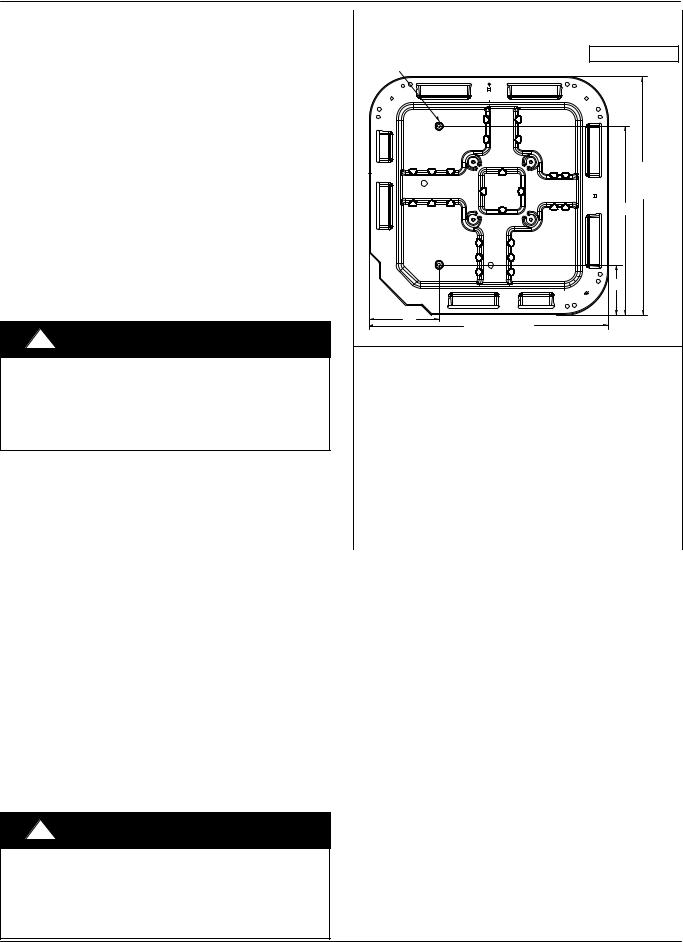
INSTALLATION INSTRUCTIONS |
R−22 Split System Heat Pump |
|
|
UNIT SUPPORT
NOTE: Unit must be level | 2 degrees {a inch rise or fall per foot of run (10mm rise or fall per 305 mm of run) } or compressor may not function properly.
A. GROUND LEVEL INSTALLATION
The unit must be level and supported above grade by beams, platform, or a pad. Platform or pad can be of open or solid construction but should be of permanent materials such as concrete, bricks, blocks, steel, or pressure− treated timbers approved for ground contact. Soil conditions must be considered so that the platform or pad does not shift or settle and leave the unit partially supported. Minimum pad dimensions are shown in Figure 2.
If beams or an open platform are used for support, it is recommended that the soil be treated or area be graveled to reduce the growth of grasses and weeds.
To minimize vibration or noise transmission, it is recommended that supports not be in contact with the building structure. However, slabs on grade constructions with an extended pad are normally acceptable.
!CAUTION
PROPERTY DAMAGE HAZARD
Failure to follow this caution may result in property damage.
Top surface of platform must be above estimated snowfall level to prevent snow blocking coil and to allow water melt to drain from unit.
B. ROOF TOP INSTALLATION
This type of installation is not recommended on wood frame structures where low noise levels are required.
Supporting structure or platform for the unit must be level. If installation is on a flat roof, locate unit minimum 6 inches (152mm) above roof level.
Place the unit over one or more load bearing walls. If there are several units, mount them on platforms that are self−supporting and span several load bearing walls. These suggestions are to minimize noise and vibration transmission through the structure. If the structure is a home or apartment, avoid locating the unit over bedrooms or study.
NOTE: When unit is to be installed on a bonded guaranteed roof, a release must be obtained from the building owner to free the installer from all liabilities.
C. FASTENING UNIT DOWN
If conditions or local codes require the unit be attached in place, remove the knockouts in the base pan and install tie down bolts through the holes (refer to Figure 2).
Contact local distributor for hurricane hold−down details and the P.E. (Professional Engineer) certification, when required.
Figure 2 |
Tie Down Knockouts |
|
|
a” (10mm) dia. Tie Down Knockouts In Base Pan (2 places)
View From Top
Base
Pan
Depth
C
B |
A |
Base Pan Width |
Inches (mm)
Base Pan |
|
Tie Down |
Minimum |
|||
Knockouts |
Mounting Pad |
|||||
Width x Depth |
||||||
A |
|
B |
C |
Dimensions |
||
|
|
|||||
|
|
|
|
|
|
|
@# ~ @# |
&w |
|
$v |
!* |
@# X~ @# |
|
(584 x 584) |
(197) |
|
(113) |
(457) |
(584 x 584) |
|
|
|
|
|
|
|
|
@%n ~ @%n |
(z |
|
$v |
@!4 |
@^ X~ @^ |
|
(652 x 652) |
(230) |
|
(113) |
(540) |
(660 x 660) |
|
|
|
|
|
|
|
|
#!8 ~ #!8 |
(z |
|
^2 |
@$s |
#!2 ~ #!2 |
|
(791 x 791) |
(230) |
|
(165) |
(625) |
(800 x 800) |
|
|
|
|
|
|
|
|
#$, ~ #$, |
(z |
|
^2 |
@*v |
#% ~ #% |
|
(887 x 887) |
(230) |
|
(165) |
(722) |
(889 x 889) |
|
|
|
|
|
|
|
|
!CAUTION
PROPERTY DAMAGE HAZARD
Failure to follow this caution may result in property damage.
Inadequate unit support may cause excessive vibration, noise, and/or stress on the refrigerant lines, leading to refrigerant line failure.
4 |
428 01 5002 00 |
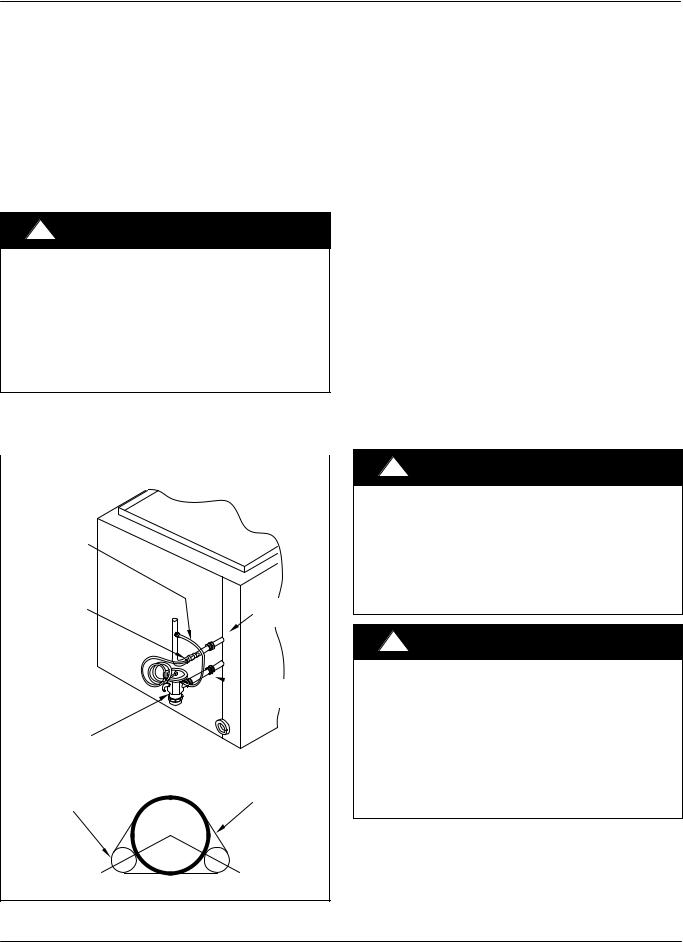
INSTALLATION INSTRUCTIONS |
R−22 Split System Heat Pump |
|
|
REFRIGERATION SYSTEM
A. COMPONENT MATCHES
Check to see that the proper system components are in place, especially the indoor coil.
R−22 outdoor units can only be used with R−22 specific indoor coils. If there is a refrigerant mis−match, consult the indoor coil manufacturer to determine if a refrigerant conversion kit is available for the indoor coil.
This outdoor unit is designed for use only with indoor coils that utilize a TXV refrigerant metering device. If any other type of metering device is installed on the indoor coil, consult the indoor coil manufacturer to determine if a TXV conversion kit is available.
!CAUTION
PRODUCT DAMAGE HAZARD
Failure to follow this caution may result in product damage.
Indoor coil and outdoor unit must be listed as a certified combination (match) in the ARI Unitary Directory of Certified Products.
Indoor coil must have R−22 specific, TXV refrigerant metering device.
When installing a TXV on an indoor coil, follow the instructions provided with the new TXV.
A typical TXV installation is shown in Figure 3.
Figure 3 |
Typical TXV Installation |
|
|
INDOOR
COIL
EQUALIZER
TUBE
SENSING |
SUCTION |
|
TUBE |
||
BULB |
||
|
 LIQUID
LIQUID
TUBE
HARD
SHUT−OFF
TXV
SENSING BULB
(EITHER SIDE) |
STRAP |
|
|
|
SUCTION |
|
TUBE |
8 O’CLOCK |
4 O’CLOCK |
B. REFRIGERANT LINE SETS
The refrigerant line set must be properly sized to assure maximum efficiency and proper oil circulation.
Refer to Product Specifications and Long Line Applications Guideline for line set sizing.
NOTE: Total line set length must not exceed 200 feet (61m).
NOTE: A crankcase heater must be used when the refrigerant line length exceeds 80 feet (24.4m).
If outdoor unit is more than 10 feet (3m)higher than the indoor coil, refer to the Long Line Applications Guideline for instructions.
NOTE: When the outdoor unit is higher than the indoor coil, the vertical separation must not exceed 100 feet (30m).
NOTE: When the outdoor unit is lower than the indoor coil, the vertical separation must not exceed 50 feet (15.2m).
If it is necessary to add refrigerant line in the field, use dehydrated or dry, sealed, deoxidized, copper refrigeration tubing. Do not use copper water pipe.
Do not remove rubber plugs or caps from copper tubing until connections are ready to be made.
Be extra careful when bending refrigeration tubing. Tubing can “kink” easily, and if this occurs, the entire length of tubing must be replaced.
!WARNING
PERSONAL INJURY HAZARD
Failure to relieve system pressure could result in personal injury and/or death.
Relieve pressure and recover all refrigerant before servicing existing equipment, and before final unit disposal. Use all service ports and open all flow− control devices, including solenoid valves.
!CAUTION
UNIT OPERATION HAZARD
Failure to follow this caution may result in improper product operation.
Do not leave system open to atmosphere any longer than absolutely required for installation. Internal system components − especially refrigerant oils − are extremely susceptible to moisture contamination. Keep ends of tubing sealed during installation until the last possible moment.
428 01 5002 00 |
5 |
